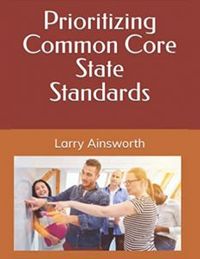TIMELESS PRACTICES TO IMPROVE STUDENT LEARNING
Supporting educators and leaders in their important work of helping every student become a confident and successful learner
Prioritizing the Common Core And Power Standards
TIMELESS PRACTICE #1
BOOK DESCRIPTION:
So many standards, so little time! Here’s how Dr. Robert Marzano concluded his research (2001) on the issue: “The sheer number of standards is the biggest impediment to implementing standards.”
In 2003, I wrote Power Standards: Identifying the Standards That Matter the Most to address this challenge. I republished this original work in 2023 as a 20th Anniversary Reprint entitled, Power Standards: Identifying the Standards Essential for Student Success. The process works great, then as well as now, but in the past, many misinterpreted the term “power” to mean only that certain standards were important and not to worry if they didn’t get to the others. As a result, I rebranded the process, Priority Standards, to underscore the point that certain standards should receive greater instructional emphasis than others, but that all standards must still be taught. The cautionary phrase became, “Prioritization, NOT elimination!”
In 2013, I wrote Prioritizing the Common Core: Identifying Specific Standards to Emphasize the Most (republished as Prioritizing Common Core State Standards in 2021). Applicable to all standards in all grade levels in every state, not just the Common Core, this volume updates and expands the original process by clearly distinguishing Priority Standards as the most rigorous or comprehensive ones, and the others—the Supporting Standards—as the instructional scaffolds to the priorities. Below is a synopsis of what you can expect to gain from utilizing this proven "timeless" practice--still as relevant and needed today as ever before.
SYNOPSIS:
Prioritizing the Common Core: Identifying Specific Standards to Emphasize the Most (2013), Now Prioritizing Common Core State Standards (2021)
A comprehensive update to the original book! Although written to address the Common Core standards in both ELA and math, the rationale, process, and examples are directly relevant and applicable to all state standards in the U.S. and all provincial learning outcomes in Canada.
Features of the book include:
- In-depth rationale for prioritizing the Common Core State Standards.
- Charts showing the large numbers of CCSS at every grade level, K-12, in both ELA and math.
- Step-by-step process explaining how to prioritize the K–12 standards, in both content areas.
- Reader’s Assignments to immediately apply the information and select your Priority Standards.
- Practical strategies for soliciting feedback from all participants, especially those not involved in the initial selection process.
- Narratives by district leaders from six different school districts in six different states describing how they identified their Priority Standards.
SYNOPSIS:
Power Standards: Identifying the Standards Essential for Student Success, 20th Anniversary Reprint (2023)
Certain standards require more in-depth instruction than others to prepare students for current and future success—in school, in life, and on high-stakes assessments. Power Standards: Identifying the Standards Essential for Student Success is a practical, “how-to” manual that explains step-by-step how teams of educators can collaboratively identify and vertically align, K-12, the Power Standards – those standards that are essential for student success.
In this 20th anniversary reprint, author Larry Ainsworth shows all educators not only how to create a prioritized subset of their own state or district standards, but also how to use these Power Standards to guide the development of meaningful curriculum and assessment. The straightforward and easy-to-read format enables readers to immediately apply these proven, practical strategies. Numerous examples of prioritized standards in several content areas and grade levels from different school districts show educators, instructional coaches, and leaders how to focus instruction and assessment on Power Standards to significantly improve achievement for all students.
Preview of the Topics in this 20th Anniversary Reprint:
- Why Power Standards?
- How to Identify Power Standards
- Involving Everyone in the Process
- Wayne Township, Indianapolis, Indiana
- Caldwell, Idaho
- Palm Springs, California
- Frequently Asked Questions
- Identifying Power Standards: The Step-by-Step Process
- “Unwrapping” Power Standards
PROCESS:
OVERVIEW OF THE PROCESS – HOW TO PRIORITIZE
To prevent differing professional opinions from getting in the way of reaching a consensus as to which standards to choose (state, provincial, or Common Core), K–12 teams use these objective selection criteria:
- Endurance (lasting beyond one grade or course; concepts and skills needed in life)
- Leverage (crossover applications within the content area and to other content areas; i.e., interdisciplinary connections)
- Readiness for next level of learning (prerequisite concepts and skills students need to enter a new grade level or course of study)
- External exam requirements (national, state, provincial, college, and career)
Keeping in mind these four important criteria, they then follow these steps:
Step 1: Make initial selections using selection criteria. Reach initial consensus.
Step 2: Look for connections to state tests. Make changes as needed.
Step 3: Chart selections for each grade.
Step 4: Vertically align Priority Standards K-12. Resolve uncertainties. Reach group consensus.
Step 5: Acquire feedback from all sites.
Step 6: Revise, publish, and distribute.
Source: Larry Ainsworth, Prioritizing the Common Core, 2013, p. 36
Larry Talks About Priority Standards
Genesee Valley Educational Partnership, New York—Evaluation of Priority Standards Keynote by Larry Ainsworth
“Helping to see the process of prioritizing the standards will allow us to take it back to district teachers”
“The criteria to help prioritize the standards”
“Good refresher of important information needed for student success”
“HOW to help teachers prioritize the standards”
“As district superintendent, this was a valuable session for me.”
“Practical application—able to take back and implement”
“How easy this process can be!”
“This is a critical process for districts to undertake, so making sure that all districts have this knowledge is important.”
“I thought it was a great day! Larry was organized and extremely relatable, and I love that he understands where teachers are at. I also loved the conversations we had around vertical articulation of the standards.”
Cherry Creek School District, Colorado—Evaluation of Priority Standards Keynote by Larry Ainsworth
“Excellent flow and mix of learning and workshop! This process is easily replicated!”
“The format and progression of the day was very strategic and effective. Great pacing!”
“I was able to visualize the entire process of prioritizing and then ‘unwrapping’ the standards on a large scale.”
“Experiencing the vertical alignment step of the process was the most valuable part of the day for me.”
“Great to go through the process! Excited to move forward with this in CCSD. I’m interested to get into this process with teachers and leadership.”
(I now realize that this) “CAN be done when it’s thoughtful, purposeful, and shared. Thank you for your experience and empowerment.”
“To be honest, I wasn’t excited going into today’s presentation. Larry was great, though! He really knows how to capture his audience.”
“The most valuable thing I learned today was that prioritization can be done in a district as large as CCSD.”
“Excellent workshop! The work is manageable for this team!”
“I feel we are so much closer to where we need to be. The language to describe the importance of this work was key! The energy was good! Thank you! ☺
“Seeing the crossover connections between grade levels during the vertical alignment working session was valuable to me.”
“I loved the process for prioritizing standards. It seems logical and a worthwhile process for teacher teams to do—something that is very doable.”
“Larry was very knowledgeable and had lots of supporting information, suggestions, and insights. Very much appreciated! Looking forward to your continued support on this project. Thank you for understanding the needs and challenges of our district!”
“Thank you for your open, positive approach. You made us feel like we could ask questions and get clarification.”
“This will be so helpful! I love that we worked through the process. I feel like I can really support my teachers.”
“Important work that should have been done earlier in standards implementation. Schools will find this valuable.”
“I really appreciate how you started with clear rationale and statistics. It was powerful. Oh, and I loved the criteria to prioritize—very clear!”
“Larry created a safe, intelligent space to dive into this work.”
“I appreciated the hands-on application—effective protocols to synthesize and process the information.”
“One of the most valuable professional development sessions I have been to!”
“Larry was very well prepared—honored work to date and took time to understand what we do and what we already have in place.”
“He finished the day strongly communicating his viewpoints clearly and facilitating the prioritization experience well.”
“This has the potential, if done well, to help teachers have clarity and buy-in into continuing the work of effective and engaging instruction for kids.”






